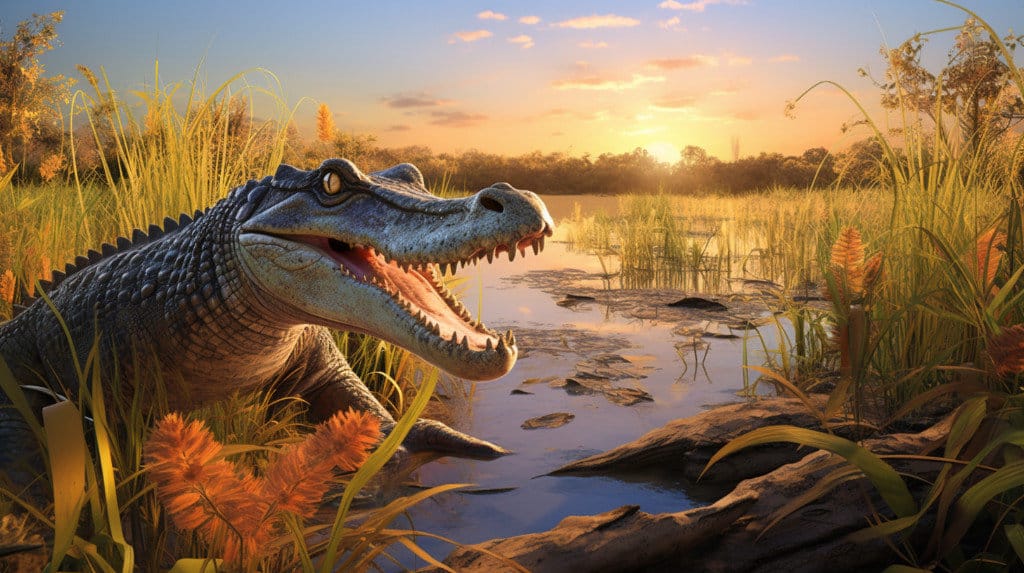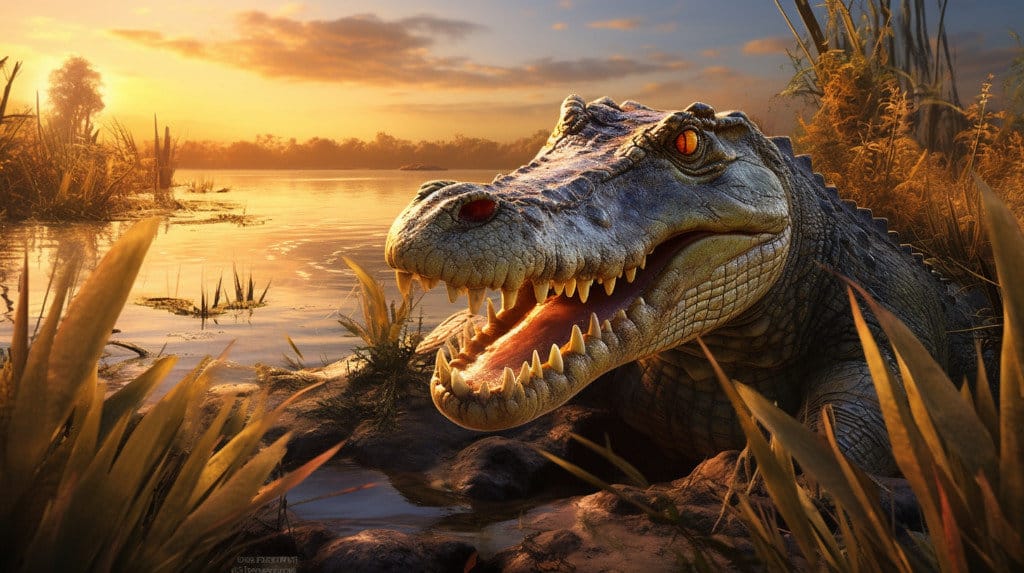Crocodiles are fascinating creatures that have captured the imagination of people around the world. These ancient reptiles can be found in various parts of the world, inhabiting both freshwater and saltwater environments. They are most commonly found in tropical regions, where the climate is warm and the water is abundant. Some of the countries where crocodiles can be found include Australia, India, Egypt, South Africa, and the United States. These powerful predators are well-adapted to their habitats, with their strong jaws, sharp teeth, and excellent swimming abilities. Now, let’s take a look at some key takeaways about where crocodiles live:
Key Takeaways
| Location | Habitat |
|---|---|
| Australia | Freshwater rivers, swamps, and coastal regions |
| India | Rivers, lakes, and mangrove swamps |
| Egypt | Nile River and surrounding areas |
| South Africa | Rivers, estuaries, and freshwater marshes |
| United States | Southern states, such as Florida and Louisiana |
Understanding Crocodiles: An Overview

Crocodiles are fascinating creatures that have captured the imagination of people around the world. These ancient reptiles have been around for millions of years and have adapted to thrive in various environments. In this overview, we will explore the lifespan of crocodiles, how they survive in different environments, and the difference between crocodiles and alligators.
The Lifespan of Crocodiles
Crocodiles are known for their long lifespans, with some species living up to 70 years or more. The exact lifespan of a crocodile can vary depending on factors such as species, habitat, and environmental conditions. For example, Nile crocodiles, which are found in Africa, can live for several decades, while American crocodiles have been known to live up to 70 years.
How Crocodiles Survive in Different Environments
Crocodiles are highly adaptable creatures and can be found in a wide range of habitats across the globe. They are commonly found in tropical regions, where they inhabit swamps, rivers, and marshlands. Some species, like the estuarine crocodile, can even be found in mangrove swamps and estuaries.
Crocodiles have unique adaptations that allow them to survive in different environments. For instance, saltwater crocodiles are able to tolerate high salinity levels and can be found in coastal areas and estuaries. Freshwater crocodiles, on the other hand, prefer freshwater habitats such as lakes and rivers.
In their respective habitats, crocodiles play a crucial role in maintaining the balance of the ecosystem. They are apex predators and help control the population of other animals, such as fish and birds. Their presence also ensures the health of wetland ecosystems.
The Difference Between Crocodiles and Alligators
While crocodiles and alligators may appear similar at first glance, there are some key differences between the two. One noticeable difference is in their physical appearance. Crocodiles have a V-shaped snout, while alligators have a U-shaped snout. Additionally, crocodiles tend to have a more aggressive nature compared to alligators.
Another difference lies in their geographical distribution. Crocodiles are found in tropical and subtropical regions around the world, including Africa, Australia, America, and Asia. Alligators, on the other hand, are primarily found in the United States and China.
In terms of behavior, crocodiles are known to be more aggressive and are capable of living in saltwater habitats. Alligators, on the other hand, are generally less aggressive and prefer freshwater environments.
In conclusion, crocodiles are remarkable creatures that have adapted to survive in various environments. Their long lifespan, ability to thrive in different habitats, and distinct characteristics make them a truly fascinating species. Whether you encounter a crocodile in the wild or learn about them from afar, these ancient reptiles are sure to leave a lasting impression.
The Habitats of Crocodiles

Crocodiles are fascinating creatures that inhabit a variety of environments around the world. They have adapted to live in diverse habitats, ranging from freshwater rivers and lakes to coastal estuaries and mangrove swamps. Let’s explore the different environments where crocodiles can be found and understand why they are so well-suited to these habitats.
What Environment Do Crocodiles Live In
Crocodiles can be found in both freshwater and saltwater habitats. Freshwater crocodiles are commonly found in tropical regions, inhabiting rivers, lakes, and marshlands. They are known for their ability to tolerate a wide range of salinity levels in the water, making them adaptable to different environments.
On the other hand, saltwater crocodiles are primarily found in coastal areas and estuaries. These large and powerful reptiles are known to venture into the open ocean as well. They are commonly found in regions such as Venezuela, Mexico, and Australia, where the salinity of the water is higher. The coastal areas and estuaries provide an ideal habitat for saltwater crocodiles, as they offer a diverse range of food sources and suitable nesting grounds.
Why Crocodiles Live in Water
Crocodiles are well-adapted to an aquatic lifestyle, and there are several reasons why they prefer to live in water. Firstly, water provides crocodiles with a reliable source of food. They are opportunistic predators and feed on a variety of animals such as fish, birds, and small mammals. Being in the water allows them to easily catch their prey and ensures a steady supply of food.
Secondly, water helps regulate the body temperature of crocodiles. They are ectothermic, meaning they rely on external sources of heat to regulate their body temperature. By residing in water, crocodiles can cool down during hot weather and warm up in colder temperatures. This adaptation allows them to thrive in a wide range of climates, from subtropical regions to cooler areas.
The Unique Habitats: Forest Floor and Swamps
Apart from their affinity for water, crocodiles also inhabit unique habitats such as the forest floor and swamps. In forested areas, crocodiles can be found basking in the sun on the forest floor, near bodies of water. This behavior allows them to regulate their body temperature and provides camouflage from potential predators.
Swamps, particularly mangrove swamps, are another favored habitat for crocodiles. These wetland ecosystems offer a perfect blend of water and land, providing crocodiles with an abundance of food and suitable breeding grounds. The dense vegetation of mangrove swamps also offers protection and camouflage for crocodiles, making it an ideal habitat for them to thrive.
In conclusion, crocodiles have adapted to a wide range of habitats, from freshwater rivers and lakes to coastal estuaries and mangrove swamps. Their ability to live in diverse environments is a testament to their remarkable adaptations and survival strategies. Understanding their habitats is crucial for crocodile conservation efforts and ensuring the long-term survival of these incredible reptiles.
The Geographic Distribution of Crocodiles

Where Do Crocodiles Live in the World: An Overview
Crocodiles are fascinating creatures that can be found in various parts of the world. They have a wide geographic distribution, inhabiting both freshwater and saltwater environments. Let’s take a closer look at where these incredible reptiles can be found across the globe.
Crocodiles in North America
In North America, crocodiles can be found in the southern regions, particularly in the coastal areas of Florida and the Gulf of Mexico. These areas provide the perfect habitat for crocodiles, with their estuaries and coastal marshlands offering an abundance of food and suitable nesting grounds. The warm temperatures and freshwater sources also contribute to the thriving crocodile population in this region.
Crocodiles in Australia
Australia is home to a diverse range of crocodile species, including the iconic saltwater crocodile. These reptiles can be found in various parts of the country, particularly in the northern regions where the climate is tropical. The vast wetland ecosystems, such as mangrove swamps and estuaries, provide the ideal environment for crocodiles to thrive. The Australian crocodiles are known for their adaptability and can survive in both freshwater and saltwater habitats.
Crocodiles in Asia
Asia is another continent where crocodiles can be found. Countries like India, Indonesia, and Malaysia are home to several crocodile species, including the estuarine crocodile. These reptiles are commonly found in rivers, lakes, and coastal areas, where they can find an abundant food supply. The warm climate and wetland habitats in these regions create the perfect conditions for crocodiles to live and breed.
Crocodiles in Africa
Africa is renowned for its diverse wildlife, and crocodiles are no exception. The continent is home to various crocodile species, with the Nile crocodile being the most well-known. These crocodiles can be found in freshwater habitats such as rivers, lakes, and marshlands across different African countries. The tropical and subtropical climates in Africa provide the ideal conditions for crocodiles to thrive and establish their breeding grounds.
Crocodiles in Central America: Costa Rica
In Central America, Costa Rica stands out as a country where crocodiles can be found. The coastal areas and river systems in Costa Rica provide an excellent habitat for crocodiles. These reptiles can be found in both freshwater and saltwater environments, adapting to the varying salinity levels. Crocodiles in Costa Rica play a crucial role in the local ecosystems, maintaining a balance by controlling the population of fish and other prey species.
Crocodiles are fascinating creatures that have adapted to various environments around the world. Their distribution is influenced by factors such as habitat availability, temperature, and food sources. Understanding their geographic distribution helps in conservation efforts and ensures the preservation of these incredible reptiles for future generations.
The Behavior and Social Structure of Crocodiles
Crocodiles are fascinating creatures that inhabit various habitats around the world. They are found in both freshwater and saltwater environments, including swamps, rivers, marshlands, and mangrove swamps. Different species of crocodiles can be found in tropical and subtropical regions, such as Africa, Australia, America, and Asia. These reptiles have adapted to thrive in wetland ecosystems and have unique behaviors that contribute to their social structure.
Why Do Crocodiles Live in Groups
Crocodiles are known to exhibit both solitary and social behaviors, depending on their species and environmental conditions. While some crocodiles prefer a solitary life, others live in groups for various reasons. Here are some factors that contribute to crocodiles living in groups:
-
Habitat Availability: Crocodiles tend to form groups in areas where suitable habitats are abundant. Coastal areas and estuaries provide an ideal environment for crocodiles to find food, mate, and establish territories.
-
Food Availability: Crocodiles living in groups benefit from the increased availability of food resources. In areas with high fish and bird populations, crocodiles can find ample prey to sustain themselves.
-
Protection and Safety: Living in groups offers crocodiles protection against potential threats. By forming groups, they can deter predators and defend their territories more effectively.
-
Breeding Grounds: Group living is particularly common during the breeding season when crocodiles gather in specific areas to mate and lay eggs. These breeding grounds provide a social structure that allows for successful reproduction.
The Solitary Life: Why Some Crocodiles Live Alone
While group living is common among crocodiles, there are also species that prefer a solitary lifestyle. Here are some reasons why some crocodiles live alone:
-
Territorial Behavior: Crocodiles are territorial creatures, and some individuals prefer to establish their own territories without the presence of others. This allows them to have exclusive access to resources and minimize competition.
-
Limited Resources: In areas where resources are scarce, crocodiles may choose to live alone to avoid competition for food and nesting sites. This solitary lifestyle ensures their survival in environments with limited resources.
-
Temperature Regulation: Crocodiles are ectothermic, meaning they rely on external sources of heat to regulate their body temperature. Solitary crocodiles can bask in the sun without competition, allowing them to warm up more efficiently.
-
Hunting Efficiency: Some crocodile species have developed hunting strategies that are more effective when they hunt alone. By hunting alone, they can stealthily approach their prey without alerting other crocodiles.
In conclusion, crocodiles exhibit a range of behaviors and social structures depending on their species and environmental conditions. While some crocodiles live in groups to benefit from habitat availability, food resources, protection, and breeding grounds, others prefer a solitary life to establish territories, cope with limited resources, regulate their body temperature, and hunt efficiently. Understanding these behaviors and social structures is crucial for the conservation and management of crocodile populations in the wild.
The Adaptability of Crocodiles
Crocodiles are remarkable creatures known for their incredible adaptability. They have evolved over millions of years to survive in various habitats and climates, making them one of the most successful reptiles on Earth.
How Crocodiles Survive Winter
Crocodiles have developed unique strategies to survive the harsh conditions of winter. In colder regions, such as subtropical climates, crocodiles can enter a state of dormancy known as brumation. During this period, their metabolism slows down, and they become less active to conserve energy. They may also seek out warmer areas, such as deep burrows or sunlit spots, to maintain their body temperature.
How Crocodiles Live in Water and Land
Crocodiles are well adapted to both aquatic and terrestrial environments. They are excellent swimmers, thanks to their streamlined bodies, powerful tails, and webbed feet. Their eyes, ears, and nostrils are located on the top of their heads, allowing them to stay mostly submerged while still being able to see, hear, and breathe. This adaptation enables them to hunt and ambush their prey in the water.
On land, crocodiles are surprisingly agile despite their large size. They can walk and even gallop short distances using their strong legs. Their tough, scaly skin provides protection from the elements and helps retain moisture, allowing them to survive in arid regions. Crocodiles also dig burrows near water sources, which serve as shelter during dry periods.
Why Crocodiles Live in Saltwater
Some crocodile species, such as the estuarine crocodile, are well adapted to living in saltwater habitats. These areas, like coastal estuaries, provide an abundant food supply for crocodiles. The salinity of the saltwater also helps prevent the growth of bacteria and parasites, reducing the risk of infections.
Crocodiles in saltwater areas commonly feed on fish, birds, and other small animals that thrive in these environments. The temperature of the saltwater is also more stable compared to freshwater, allowing crocodiles to find food year-round. Additionally, the saltwater helps keep their bodies warm, especially during colder seasons.
In regions like Venezuela and Mexico, where the salinity of the water is lower, crocodiles can also be found in freshwater lakes and rivers. They adapt to the lower salinity levels and continue to find food and suitable habitats in these areas.
Crocodiles are truly remarkable creatures that have successfully adapted to a wide range of habitats and climates. Their ability to thrive in wetland ecosystems, mangrove swamps, and even subtropical regions is a testament to their resilience and evolutionary success. It is important to continue studying and conserving these fascinating reptiles to ensure their survival and maintain the balance of their ecosystems.
Conclusion
In conclusion, crocodiles are fascinating creatures that can be found in various parts of the world. They are well-adapted to their environments and have managed to survive for millions of years. From the freshwater rivers and lakes of Africa, Australia, and the Americas to the brackish mangrove swamps of Asia, crocodiles have established their presence in diverse habitats. These apex predators play a crucial role in maintaining the balance of ecosystems they inhabit. Despite their fearsome reputation, crocodiles are an important part of our natural world and deserve our respect and conservation efforts.
Frequently Asked Questions
Where do crocodiles live in America?
Crocodiles, specifically the American crocodile species, can be found in the southernmost tip of Florida in the United States. They inhabit coastal areas, mangrove swamps, and estuaries.
How do crocodiles survive?
Crocodiles are highly adaptable creatures. They survive in a variety of habitats such as rivers, swamps, and marshlands in tropical and subtropical climates. They are excellent swimmers and can survive both in freshwater and saltwater environments. Their diet primarily consists of fish, birds, and mammals.
What do crocodiles eat?
Crocodiles are carnivores. Their diet includes a variety of fish, birds, and mammals. Larger crocodiles can also prey on larger mammals such as deer or buffalo.
How often do you watch crocodiles live?
This would depend on your personal interest and access to a live feed or habitat. Some wildlife reserves and zoos have live webcams that allow you to watch crocodiles in real time.
Why do crocodiles live in water?
Crocodiles are semi-aquatic creatures. They live in water as it helps them regulate their body temperature, provides a medium for hunting prey, and is essential for their breeding and nesting behavior.
How long do crocodiles live without food?
Crocodiles can survive for long periods without food due to their slow metabolism. They can live without food for months and in extreme cases, they have been known to survive up to two years without eating.
Where do crocodiles live vs alligators?
Crocodiles and alligators have different geographical distributions. While crocodiles are found in Africa, Asia, the Americas, and Australia, alligators are primarily found in the United States and China. Crocodiles prefer saltwater habitats, whereas alligators are more commonly found in freshwater environments.
How do crocodiles live in water and land?
Crocodiles are semi-aquatic, meaning they can live in both water and land. They are excellent swimmers and can also move on land by sliding on their bellies or walking in a high walk.
How old do crocodiles live up to?
Crocodiles have a long lifespan. On average, they can live up to 70-100 years, with some species known to live even longer.
Why do crocodiles live in rivers?
Crocodiles live in rivers because it provides them with the necessary conditions for survival. Rivers are home to a variety of prey, offer suitable nesting sites, and help crocodiles regulate their body temperature.




